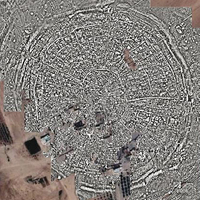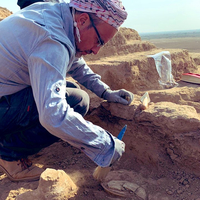In C. CASTEL, J.-W. MEYER, Ph. QUENET (éd.), Circular Cities of Early Bronze Age Syria, SUBARTU XLII, Turnhout, Brepols Publishers, p. 3-22 + pl.1 p. 389. , 2020
Circular and fortified archaeological sites of the third millennium B.C. are numerous in Syria, a... more Circular and fortified archaeological sites of the third millennium B.C. are numerous in Syria, although other types of settlements are attested. These Early Bronze Age circular sites are numerous not only in Upper Mesopotamia, but also in Western-Central Syria, as recent discoveries in the Shamiyah region have revealed.
We compare here rapidly, as a kind of introduction to the volume, a few of these settlements, Tell Al-Rawda, Tell Chuēra, Kharab Sayyar and Tell Sh‘airat, which enable the identification of a true “urban model”. These cities are not only circular in form and enclosed by a more or less circular fortification wall, their urban fabric is specific: it is characterised by its geometry, the density of buildings intra-muros and an urban system organised around a network of concentric and radial streets. This urban model seems to have appeared early, when the first properly “Syrian cities” emerged at the beginning of Early Bronze Age I, around 3100 B.C., and disappeared around 2200 B.C. It reveals the existence of city planners, among the first in history. We briefly introduce here what this urban model suggests in terms of symbolism and sociology, and what it reveals concerning the nature of power in the Early Bronze Age.
We then examine other more or less circular third millennium Syrian sites in order to show that some of them cannot be considered to be cities, while others are too poorly known to confirm that they correspond to the urban model that we have identified.
This discussion, which is based on examination of empirical archaeological data, leads us to reconsider the term Kranzhügel and to abandon it, as it evokes quite different conceptions and cannot be used to indicate a particular type of Early Bronze Age settlement. This term does not adequately take into account the chronology of the sites, refers to no single model of urbanism, and has no relation to any cultural, social or “ethnic” unity. Also, the reasons for the existence of the circular Syrian cities of the third millennium appear to be various. We prefer, therefore, to abandon this term in favour of an urban model: circular fortified cities organised around a radio-concentric street layout. This urban model, which demonstrates that these cities were planned before being built, is specific to the Early Bronze Age of Syria. It appears to have resulted from a local development of urban communities, before spreading widely through the Shamiyah region in the mid-third millennium, as a process of controlled colonisation of the steppe lands, leading to the foundation of a network of contemporary cities along the Very Long Wall










Uploads
Books by Corinne Castel
These two sites document the fascinating question of the third millennium BC “circular cities” of Syria. These cities are fortified and organised around a network of concentric and radial streets. With other sites of the same morphology, they illustrate a particular form of the endogenous process of urbanization which manifested itself in this region at the birth of the first cities and territorial states. The main results obtain on these two sites, clearly planned before being built, are here confronted to the discoveries made in other Syrian “circular” cities of the Early Bronze. The 29 contributions, written by the best specialists coming from eight different countries, bring about a rich reflection on the process of urbanization in the Near East questioning the model of Southern Mesopotamia as the unique cradle of urban civilisation.
Papers by Corinne Castel
and Tell Shʻaīrat, and the surveys conducted around them, unexpectedly highlighted the arid zone
of inner Syria, to the north of Palmyra (in the so called ‘Shamiyah region’). In this article, the coauthors,
who are also respectively co-directors of the two archaeological expeditions, demonstrate that
Tell Al-Rawda and Tell Shʻaīrat have a common regular and geometric urban pattern, which indicates
the cities are pre-planned ‘new cities’. This reveals the discovery of an urban model, also recognized
in northern Syria and largely diffused in the steppe land. Both sites appear as key to understanding the
dynamic of urbanization in Syria. They certainly illustrate the birth of a precocious territorial state,
possibly connected to the ‘Very Long Wall’, onto the desert margins of Syria in a context of territorial
conquest. This event took place around 2500 BC, before the construction of Palace G of Ebla. The paper
also offers a comparison between different items of material culture from the two sites.
Paris, Publication de l’Ambassade de France au Sultanat d’Oman, Ministère des Affaires Étrangères, Le Monde autrement éditions
We compare here rapidly, as a kind of introduction to the volume, a few of these settlements, Tell Al-Rawda, Tell Chuēra, Kharab Sayyar and Tell Sh‘airat, which enable the identification of a true “urban model”. These cities are not only circular in form and enclosed by a more or less circular fortification wall, their urban fabric is specific: it is characterised by its geometry, the density of buildings intra-muros and an urban system organised around a network of concentric and radial streets. This urban model seems to have appeared early, when the first properly “Syrian cities” emerged at the beginning of Early Bronze Age I, around 3100 B.C., and disappeared around 2200 B.C. It reveals the existence of city planners, among the first in history. We briefly introduce here what this urban model suggests in terms of symbolism and sociology, and what it reveals concerning the nature of power in the Early Bronze Age.
We then examine other more or less circular third millennium Syrian sites in order to show that some of them cannot be considered to be cities, while others are too poorly known to confirm that they correspond to the urban model that we have identified.
This discussion, which is based on examination of empirical archaeological data, leads us to reconsider the term Kranzhügel and to abandon it, as it evokes quite different conceptions and cannot be used to indicate a particular type of Early Bronze Age settlement. This term does not adequately take into account the chronology of the sites, refers to no single model of urbanism, and has no relation to any cultural, social or “ethnic” unity. Also, the reasons for the existence of the circular Syrian cities of the third millennium appear to be various. We prefer, therefore, to abandon this term in favour of an urban model: circular fortified cities organised around a radio-concentric street layout. This urban model, which demonstrates that these cities were planned before being built, is specific to the Early Bronze Age of Syria. It appears to have resulted from a local development of urban communities, before spreading widely through the Shamiyah region in the mid-third millennium, as a process of controlled colonisation of the steppe lands, leading to the foundation of a network of contemporary cities along the Very Long Wall
For this purpose, all the available archaeological data (architecture, inventories, installations, craft areas and faunal remains) as well as some textual sources will be taken into account.
Thus, new insights into the religious practices and the functioning of a large Early Bronze Age sanctuary in Western Central Syria will be proposed.
Following a first season of joint investigations carried out at the two settlement sites of Bāt and al-Arid (15 km northwest of Bāt) in the Sultanate of Oman, during winter 2019 (Castel, Barge, Besnard et al. 2019), the MBA Mission (Mission archéologique de Bāt/al-Arid) carried out a second season of excavations at the settlement site of al-Arid in 2020.
This contribution aims to present the latest results from this extensive survey, the excavations and the different studies of this new mission, carried out by a multidisciplinary team of specialists. Three structures were excavated: one out of seven towers, with a regular internal plan, a tomb that yielded a Jemdet-Nasr plain vessel and an Umm an-Nar Black-on-Red Fine Ware pot, and a building assigned to the Late Umm an-Nar period. In addition, the investigations carried out on two abandoned irrigation canals, one of which may be related to the Bronze Age settlement, were continued. The first results obtained from the analysis of the pottery are presented and the Bayesian chronological analysis makes it possible to place all the radiocarbon dated events in the regional chronology. All these combined results shed new light on the al-Arid site and enable us to refine its chronology, thus enriching the debate on third millennium settlement patterns in the southern piedmont region of interior Oman.
Keywords: Oman, Hafit, Umm an-Nar, tower, irrigation canal
This contribution aims to present the latest results from this extensive survey, the excavations and the different studies of this new mission, carried out by a multidisciplinary team of specialists. Three structures were excavated: one out of seven towers, with a regular internal plan, a tomb that yielded a Jemdet-Nasr plain vessel and an Umm an-Nar Black-on-Red Fine Ware pot, and a building assigned to the Late Umm an-Nar period. In addition, the investigations carried out on two abandoned irrigation canals, one of which may be related to the Bronze Age settlement, were continued. The first results obtained from the analysis of the pottery are presented and the Bayesian chronological analysis makes it possible to place all the radiocarbon dated events in the regional chronology. All these combined results shed new light on the al-Arid site and enable us to refine its chronology, thus enriching the debate on third millennium settlement patterns in the southern piedmont region of interior Oman.
Keywords: Oman, Hafit, Umm an-Nar, tower, irrigation canal
These two sites document the fascinating question of the third millennium BC “circular cities” of Syria. These cities are fortified and organised around a network of concentric and radial streets. With other sites of the same morphology, they illustrate a particular form of the endogenous process of urbanization which manifested itself in this region at the birth of the first cities and territorial states. The main results obtain on these two sites, clearly planned before being built, are here confronted to the discoveries made in other Syrian “circular” cities of the Early Bronze. The 29 contributions, written by the best specialists coming from eight different countries, bring about a rich reflection on the process of urbanization in the Near East questioning the model of Southern Mesopotamia as the unique cradle of urban civilisation.
and Tell Shʻaīrat, and the surveys conducted around them, unexpectedly highlighted the arid zone
of inner Syria, to the north of Palmyra (in the so called ‘Shamiyah region’). In this article, the coauthors,
who are also respectively co-directors of the two archaeological expeditions, demonstrate that
Tell Al-Rawda and Tell Shʻaīrat have a common regular and geometric urban pattern, which indicates
the cities are pre-planned ‘new cities’. This reveals the discovery of an urban model, also recognized
in northern Syria and largely diffused in the steppe land. Both sites appear as key to understanding the
dynamic of urbanization in Syria. They certainly illustrate the birth of a precocious territorial state,
possibly connected to the ‘Very Long Wall’, onto the desert margins of Syria in a context of territorial
conquest. This event took place around 2500 BC, before the construction of Palace G of Ebla. The paper
also offers a comparison between different items of material culture from the two sites.
Paris, Publication de l’Ambassade de France au Sultanat d’Oman, Ministère des Affaires Étrangères, Le Monde autrement éditions
We compare here rapidly, as a kind of introduction to the volume, a few of these settlements, Tell Al-Rawda, Tell Chuēra, Kharab Sayyar and Tell Sh‘airat, which enable the identification of a true “urban model”. These cities are not only circular in form and enclosed by a more or less circular fortification wall, their urban fabric is specific: it is characterised by its geometry, the density of buildings intra-muros and an urban system organised around a network of concentric and radial streets. This urban model seems to have appeared early, when the first properly “Syrian cities” emerged at the beginning of Early Bronze Age I, around 3100 B.C., and disappeared around 2200 B.C. It reveals the existence of city planners, among the first in history. We briefly introduce here what this urban model suggests in terms of symbolism and sociology, and what it reveals concerning the nature of power in the Early Bronze Age.
We then examine other more or less circular third millennium Syrian sites in order to show that some of them cannot be considered to be cities, while others are too poorly known to confirm that they correspond to the urban model that we have identified.
This discussion, which is based on examination of empirical archaeological data, leads us to reconsider the term Kranzhügel and to abandon it, as it evokes quite different conceptions and cannot be used to indicate a particular type of Early Bronze Age settlement. This term does not adequately take into account the chronology of the sites, refers to no single model of urbanism, and has no relation to any cultural, social or “ethnic” unity. Also, the reasons for the existence of the circular Syrian cities of the third millennium appear to be various. We prefer, therefore, to abandon this term in favour of an urban model: circular fortified cities organised around a radio-concentric street layout. This urban model, which demonstrates that these cities were planned before being built, is specific to the Early Bronze Age of Syria. It appears to have resulted from a local development of urban communities, before spreading widely through the Shamiyah region in the mid-third millennium, as a process of controlled colonisation of the steppe lands, leading to the foundation of a network of contemporary cities along the Very Long Wall
For this purpose, all the available archaeological data (architecture, inventories, installations, craft areas and faunal remains) as well as some textual sources will be taken into account.
Thus, new insights into the religious practices and the functioning of a large Early Bronze Age sanctuary in Western Central Syria will be proposed.
Following a first season of joint investigations carried out at the two settlement sites of Bāt and al-Arid (15 km northwest of Bāt) in the Sultanate of Oman, during winter 2019 (Castel, Barge, Besnard et al. 2019), the MBA Mission (Mission archéologique de Bāt/al-Arid) carried out a second season of excavations at the settlement site of al-Arid in 2020.
This contribution aims to present the latest results from this extensive survey, the excavations and the different studies of this new mission, carried out by a multidisciplinary team of specialists. Three structures were excavated: one out of seven towers, with a regular internal plan, a tomb that yielded a Jemdet-Nasr plain vessel and an Umm an-Nar Black-on-Red Fine Ware pot, and a building assigned to the Late Umm an-Nar period. In addition, the investigations carried out on two abandoned irrigation canals, one of which may be related to the Bronze Age settlement, were continued. The first results obtained from the analysis of the pottery are presented and the Bayesian chronological analysis makes it possible to place all the radiocarbon dated events in the regional chronology. All these combined results shed new light on the al-Arid site and enable us to refine its chronology, thus enriching the debate on third millennium settlement patterns in the southern piedmont region of interior Oman.
Keywords: Oman, Hafit, Umm an-Nar, tower, irrigation canal
This contribution aims to present the latest results from this extensive survey, the excavations and the different studies of this new mission, carried out by a multidisciplinary team of specialists. Three structures were excavated: one out of seven towers, with a regular internal plan, a tomb that yielded a Jemdet-Nasr plain vessel and an Umm an-Nar Black-on-Red Fine Ware pot, and a building assigned to the Late Umm an-Nar period. In addition, the investigations carried out on two abandoned irrigation canals, one of which may be related to the Bronze Age settlement, were continued. The first results obtained from the analysis of the pottery are presented and the Bayesian chronological analysis makes it possible to place all the radiocarbon dated events in the regional chronology. All these combined results shed new light on the al-Arid site and enable us to refine its chronology, thus enriching the debate on third millennium settlement patterns in the southern piedmont region of interior Oman.
Keywords: Oman, Hafit, Umm an-Nar, tower, irrigation canal